Would for the trees
Treehouse hotels are the greenest trend in tourism and have become the stylish choice for nature lovers and design devotees. Imogen Lepere guides you around eight of the best
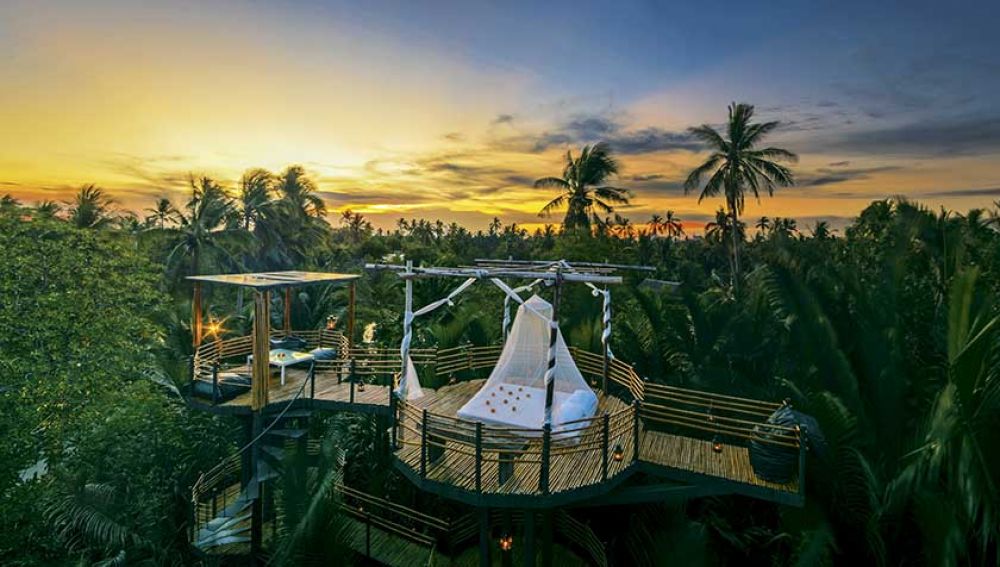
Treehouse hotels are the greenest trend in tourism and have become the stylish choice for nature lovers and design devotees. Imogen Lepere guides you around eight of the best
Legend has it that Guy Aubrey Chalkley was out inspecting his land, now a private game reserve bordering Sabi Sand and Kruger National Park, when he became aware of a pack of lions showing an interest in him. He climbed a nearby leadwood tree and stayed there all night, unwilling to shoot them.
Four generations on, his descendants built a luxury bush ‘room’ in the tree that saved their great-grandfather’s life. The Chalkley Treehouse is a two-level platform with luxurious living quarters on the top floor. You’ll eat a gourmet picnic which includes bushbuck antelope in rosemary sauce paired with South African red wine as the bushveld darkens around you.
Breathtaking by day, by night it’s full of mysterious calls. There are leopards coughing to warn other big cats off their land,
impala snorting nervously and hyenas cackling as they spot a kill. If you feel uneasy, a ranger is just a radio call away but an elevation of 9m and a secure latched door will ensure you sleep soundly – if you can tear yourself away from the stars.
Two other treehouses on the reserve are furnished in a similar style, with four-poster beds, teak chests full of extra blankets and vintage oil lamps. Kingston Treehouse is best if you’re visiting in off-season as it is partially enclosed with large windows, while Tinyeleti Treehouse sleeps a family of four and has jaw-dropping views over the Sabie River.
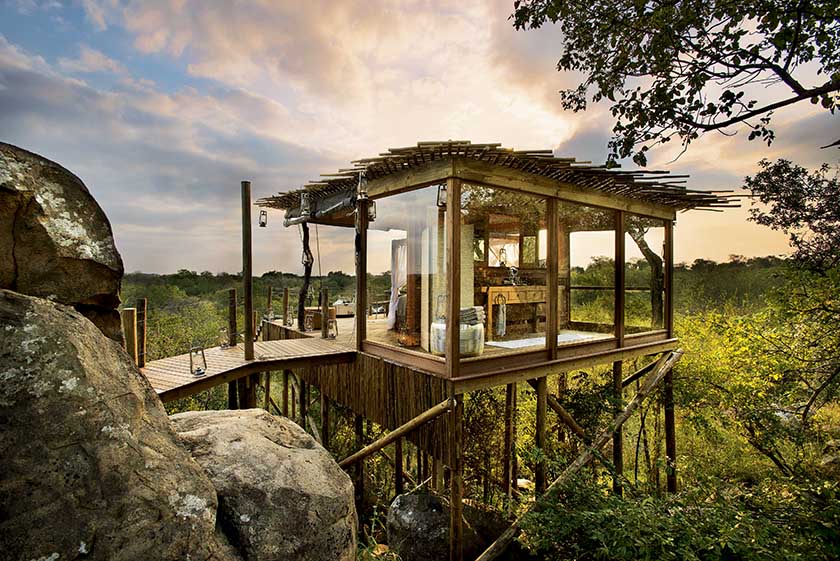
THE DETAIL Doubles from £224 per night, including breakfast, dinner, all drinks and snacks. The nearest airport is Skukuza via Johannesburg International (3km).
If The Shire from Tolkien’s Lord of the Rings trilogy suddenly relocated from Middle Earth to a forest in the Snoqualmie Valley, it would look just like TreeHouse Point.
This elevated retreat consists of six snug tree cottages, each constructed by owner Pete Nelson. Shingle roofs at jaunty angles and dainty spiral staircases create the impression you’ve stumbled upon something created without humans in mind.
Trillium is our pick of the lot. Built over two levels, its walls are mostly glass so you can admire the finery of the forest. Leather armchairs and traditional lighting are more gentlemen’s club than glamping but the ladder up to the comfortable double bed is bound to satisfy your inner child. Temple of the Blue Moon comes a close second for the trunk that grows through the middle of the room and the fact it is only accessible via a suspension bridge. All the treehouses are well heated and share a communal bathroom on the ground level.
It may be just a 35-minute drive from downtown Seattle but this fern-filled forest beside the Raging River feels like it’s in another world. Try climbing Rattlesnake Ridge, which has sweeping views of Rattlesnake Lake. T’ai chi, massages and hypnotherapy are all available, too. Breakfast, cooked by Peter’s wife Judy, is a homely affair eaten in the main lodge.
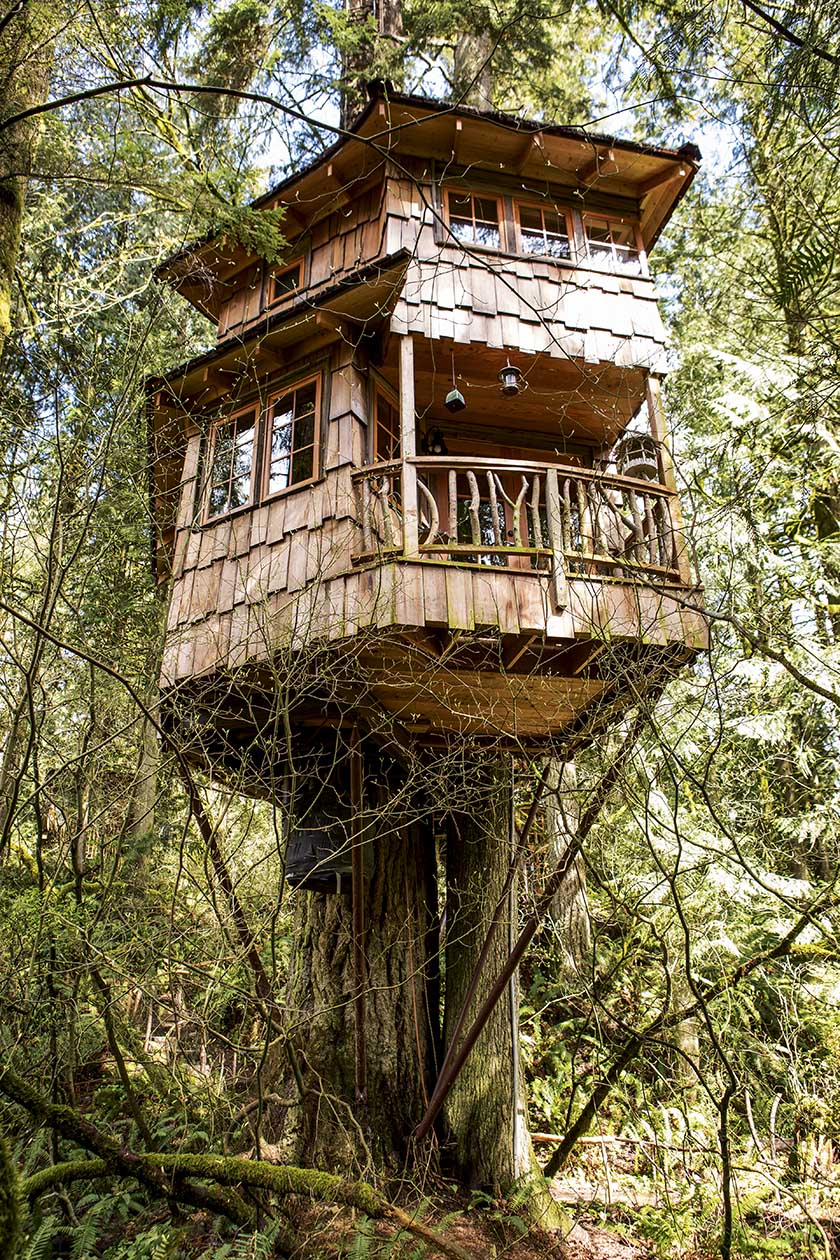
THE DETAIL Doubles from £229 per night, including homemade continental breakfast. The nearest airport is Seattle-Tacoma International (48km).
Anyone who read The Jungle Book as a kid has been haunted by memories of Shere Khan, Mowgli’s terrifying antagonist. Although there are just 3,000 Bengal tigers left in the world, at least 60 of them are known to haunt Pench National Park. These 300sq km of damp valleys and dry forests were the inspiration for Rudyard Kipling’s famous tale and they’re still roamed by sloth bears (like Baloo), wolves, pythons and, of course, tigers.
Bed down like an extremely chic and ecologically minded Mowgli in one of six new treehouses which have recently opened in this little-developed area. Set in 16ha of woodland on the edge of the village of Pench, it’s easy to imagine the fictional character playing with the Bandar-log monkeys under the Mahua trees, although he would have looked decidedly out of place in the infinity pool. Built on stilts, the treehouses blend contemporary design with traditional jungle living. Think dark wood panelling, contemporary brass bedsteads and colourful tribal fabrics opening on to balconies shaded by fig trees.
Take a jeep or walking safari to get up close to the park’s residents or cycle around the lodge’s grounds, spotting wild peacocks. Take your breakfast on the balcony and head to ‘the watering hole’ in the dining lodge for dinner. This thatched hall serves Indian and Mediterranean dishes such as rose-coloured kulfi, baked cod and broken wheat pudding.

THE DETAIL Doubles from £235 per night, including all meals. The nearest airport is Nagpur (150km).
Despite the fact it’s a key bird migration corridor between the Talamanca Mountains and the Osa Peninsula, this South Pacific forest was due to be carved into a timber harvest site. After a chance visit in 2006, Finca Bellavista founders Erica Andrews and Mateo Hogan started thinking about how they could save it. Their solution? To build a treehouse village, of course.
One of the most sustainable communities in the world, there are now 40 homes that are connected by a series of zip wires and suspension bridges. Many are permanent residences but some are available for rent. With its pagoda-style roof and cane stilts, Cabina Colibri looks vaguely oriental. Built over several levels, the lounge is level with the tree canopy and is the perfect place to watch for toucans. El Castillo Mastate is one of five treehouses that have electricity (all have hot showers) and the water in the bathroom pours out of a giant conch shell.
The site now extends over some 240ha and includes swimming holes, two whitewater rivers and huge trees that are covered in ferns and clusters of wild orchids. Some 80 per cent of life in tropical rainforests is found in the upper level of the canopy, so Finca Bellavista’s zip wire safaris open up a new realm of possibilities for wildlife spotting. All treehouses have private kitchens but the community gathers at the base camp’s open-air restaurant at night. Most of the ingredients on the simple, nourishing menu are grown on-site.
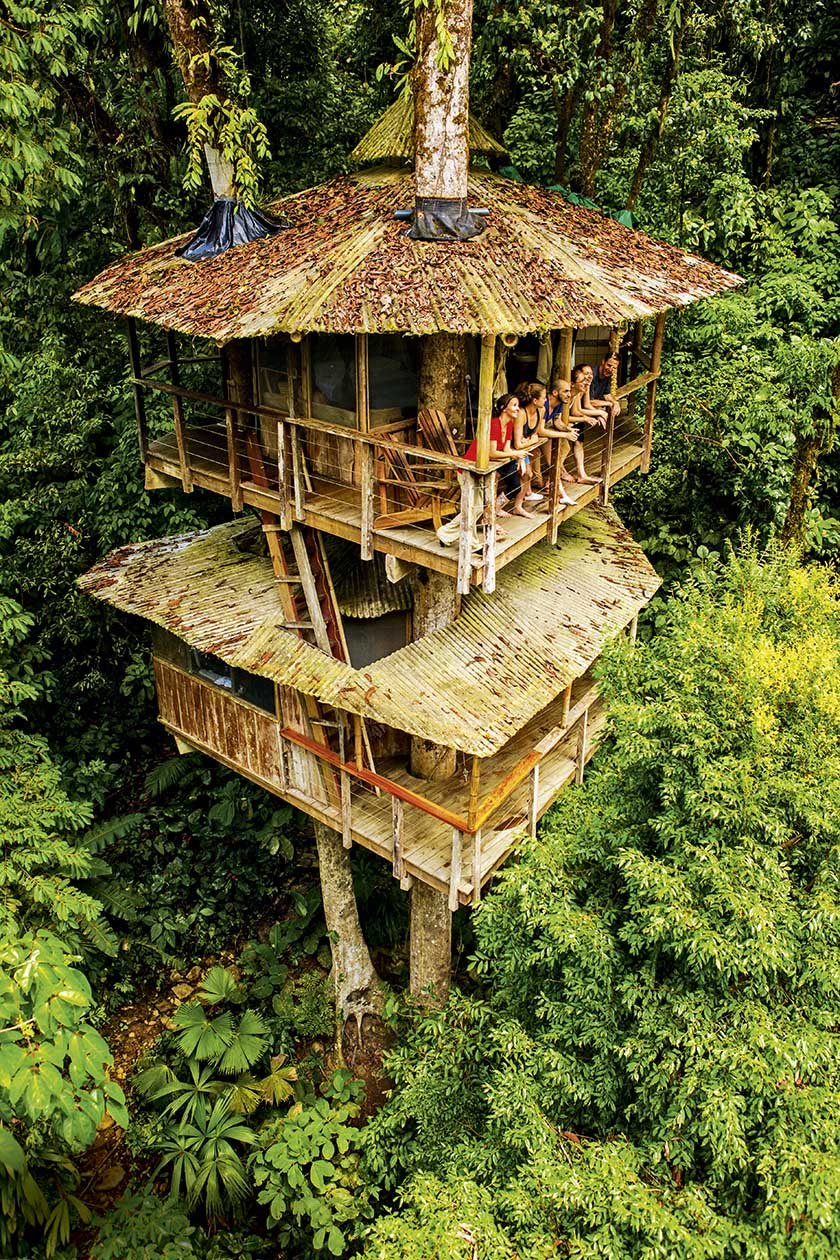
THE DETAIL Doubles from £79 per night, room only. The nearest airport is Golfito via Juan Santamaría International (40km).
We’re predicting big things for Canada’s tourism industry in 2017, in particular Vancouver Island. It floats off Canada’s famously mild Pacific coastline and is home to a vibrant arts scene, glorious beaches and excellent organic food producers. Victoria, the capital, boasts beautiful 19th-century architecture, however you need to head to Lighthouse Country to really get a sense of the island’s remoteness.
Free Spirit Spheres is a unique hotel near Qualicum Beach. Owner Tom Chudleigh comes from an engineering background. He spent three years building each of his three spherical treehouses by hand. The use of space is a delight. Beds fold down from the wall, apparently solid walnut wood panels spring open to reveal cupboards and tiny kitchens are tucked into alcoves.
There is something incredibly soothing about sleeping in a bubble that rocks gently in the breeze. Kitted out with heating, dressing gowns and kettles, they’re cosy in winter and
open to the elements in summer. With your iPod playing through the integrated speakers and the sun streaming through the open windows, it’s easy to feel like you are living inside a giant fruit growing on the tree’s branches.
The Eryn sphere has a diameter of 3m and was recently moved to a shady grove of cedar and fir trees which provide shelter on stormy nights. The Melody sphere, made of buttercup-coloured fibreglass, hangs beside a peaceful pond and is particularly appealing in warmer weather.
Vancouver Island offers some of the best cold-water diving in the world. Expect killer whales floating over shipwrecks, vibrant sea lemons and giant Pacific octopus. You can stock up on food from Qualicum Beach farmers’ market (Saturdays, March- December) and prepare it in your sphere.
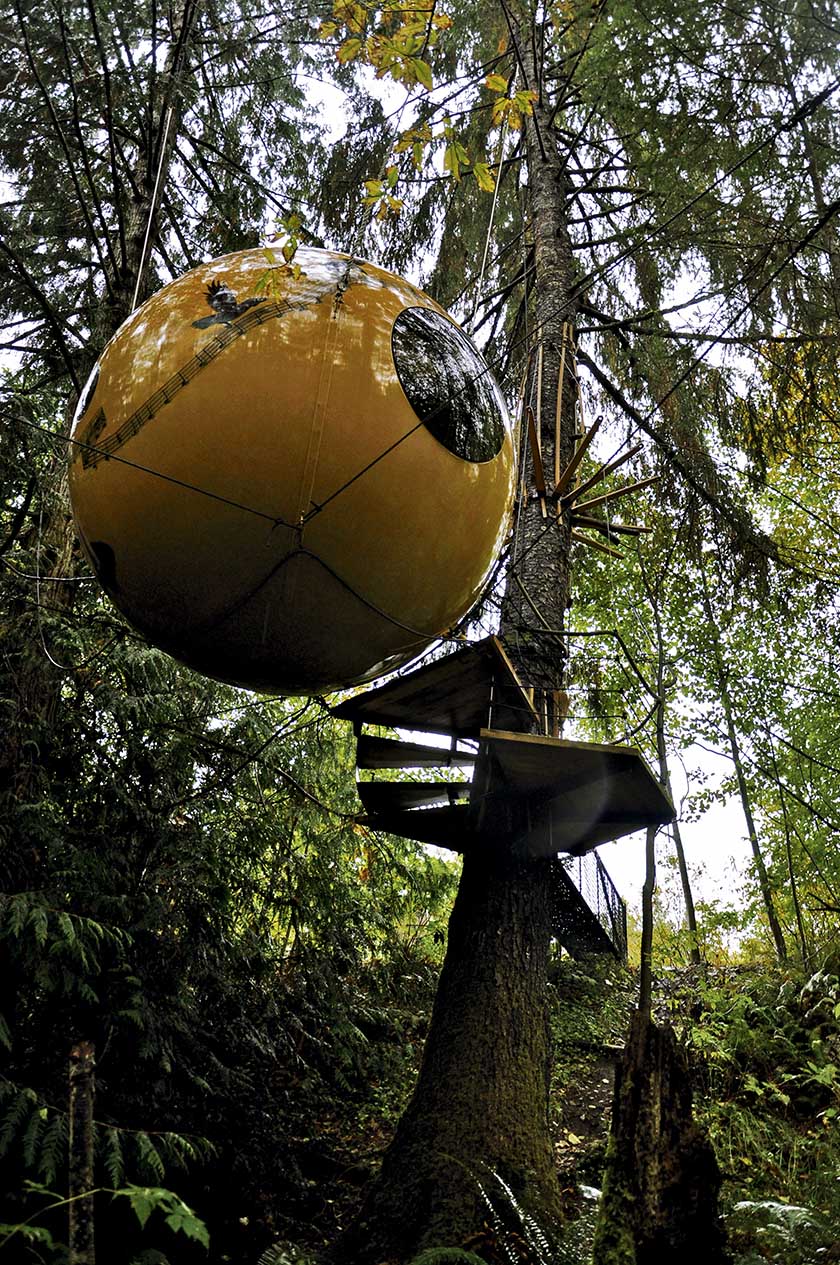
THE DETAIL Doubles from £126 per night, room only. The nearest airport is Nanaimo (74km).
We are going to stick our neck out and say that Watamu is one of the best beach destinations in Africa. The sand is bright white and as fine as sugar, it’s in a conservation area and the coral gardens are inhabited by 600 species of fish.
Arabuko-Sokoke is the largest remaining dry coastal forest in eastern and southern Africa. It’s home to vast baobab trees and troops of Sykes’ monkeys, and is so dense that it has protected the beautiful coastline from development.
The exceptions are a few traditional villages and wacky Watamu Treehouse. This seven-bedroom boutique hotel gives more than a nod to Catalonia’s Gaudi. There are no straight lines or corners. Curved stairwells wind their way to circular roof terraces, paneless windows are irregular shapes and stained glass sunk into the walls sparkles in the intense sunshine.
Deliberately built above the canopy to make the most of sea breezes and to minimise the number of trees that had to be cleared, the two towers offer 360-degree views. Rooms in the south tower are larger, with private dining areas and balconies. However, the north tower has a new open rooftop room. Taking a morning shower with trees as far as the eye can see on one side and the Indian Ocean on the other is rather special.
Every Wednesday and Saturday there are yoga sessions on the roof followed by fresh smoothies. Kitesurfing and deep-sea fishing can also be arranged, although you might find it hard to move far from the shaded pool area. Meals here are served at set times and are of the wholesome and light variety (you’re welcome to bring your own alcohol). Think fresh crabs, avocado on toast and delicious watermelon juice.
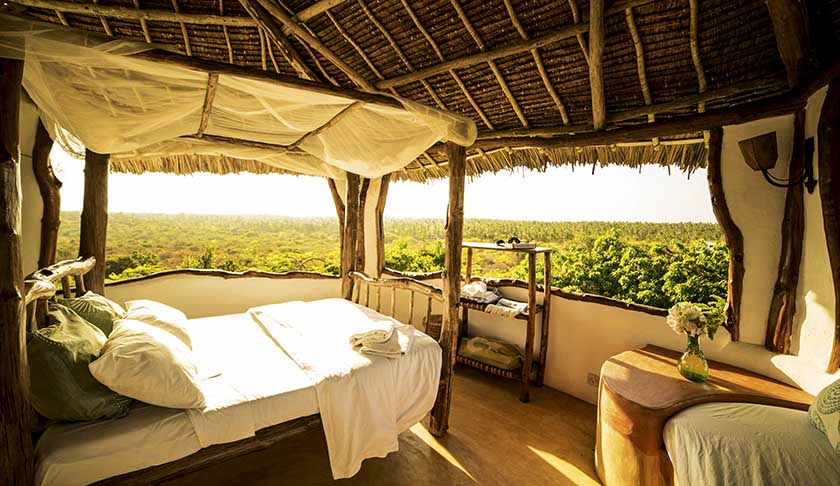
THE DETAIL Doubles from £150 per night, including breakfast. The nearest airport is Malindi (21km).
The Thai capital is a city of searing heat, swerving motorcycles, neon lights and home to almost 10 million people. If you ask one of the countless tuk-tuk (rickshaw) drivers for directions to Bang Kachao they will probably look at you blankly. However, just 6km from the business district Sala Daeng, nestled in a bend of the Chao Phraya river, is this lush island.
Thai law has protected it from development since 1977, and it’s almost entirely covered in fruit orchards and dense jungle, punctuated by 200-year-old temples. Bangkok Treehouse is the only hotel on the island and looks like it has sprung up organically, with its pier of reclaimed wood and rooms pieced together with bamboo. The Tree Top Nest is a serene, elegant space, set out over three floors and features air-conditioning. However, if you’re prepared to sacrifice electricity for a night, View with a Room is a double bed on a platform 7m off the ground in an awning of mangrove palms.
This hotel takes its responsibility to nature seriously. For every booking, 1kg of rubbish is collected from the river, all the outdoor lights are solar-powered and only staff who can walk to work are hired. The island is car-free, so make like the locals and explore its narrow lanes on one of the hotel’s free bikes.
At weekends, Bang Nampheung is a partially floating market brimming with joss sticks, jewellery and exotic fruit such as gac (baby jackfruit). Be sure to try street food favourite khao kha moo (smoky pork with sticky rice and sour chilli sauce). The hotel’s restaurant offers fresh plates with ingredients from its own kitchen garden. Expect watermelon salad with black olives and mint and dory fillet in green curry with asparagus.
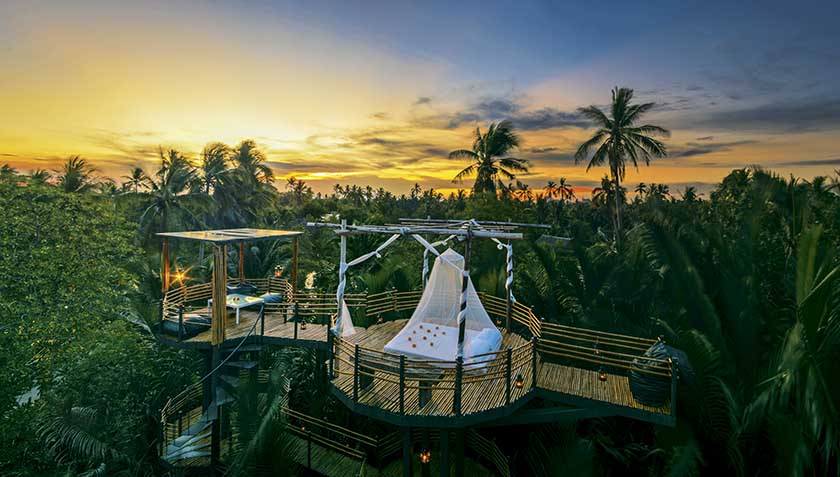
THE DETAIL Doubles from £118 per night, including breakfast and homemade ice cream. The nearest airport is Bangkok Suvarnabhumi (20km)
Not much happens in Harads, a tiny village just 50km south of the Arctic Circle. This is the heart of Sami territory (known as Sapme) and the village’s 600 residents eke out a living by fishing in the thundering Lule River, farming reindeer and taking travellers to hunt the Northern Lights.
It’s an unlikely setting for one of the world’s most groundbreaking hotels. Yet in the woodland behind the village, seven extraordinary tree rooms are pushing the boundaries of ecotourism and design. Each offers something different, while keeping the impact on nature to a minimum. The Cabin boasts the best views of the valley from its large terrace on the hillside. Futuristic The UFO stands in stark contrast to its surroundings and sleeps five. For sleek interiors trimmed in shearling, try The Dragonfly, while The 7th Room has a net 10m above the ground where you can lie and look at the stars.
In winter, temperatures can plunge to -14C so you’ll find yourself reaching for porc (forest berry schnapps) and spending hours in the sauna. In warmer weather, the Essence of Lapland tour (book a week in advance) is a must. Local artist Eva Gunnare will guide you through the forest, pointing out wild herbs used in regional medicine. Meals are cooked by cofounder Britta Lindvall and served in her cosy guesthouse; expect Nordic favourites such as moose with potatoes and cloudberry jam.

THE DETAIL Doubles from £426 per night, including breakfast. The nearest airport is Luleå (108km).
Subscribe and view full print editions online... Subscribe